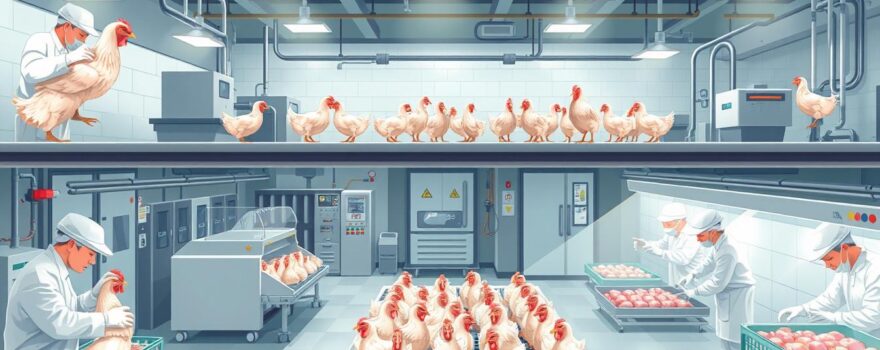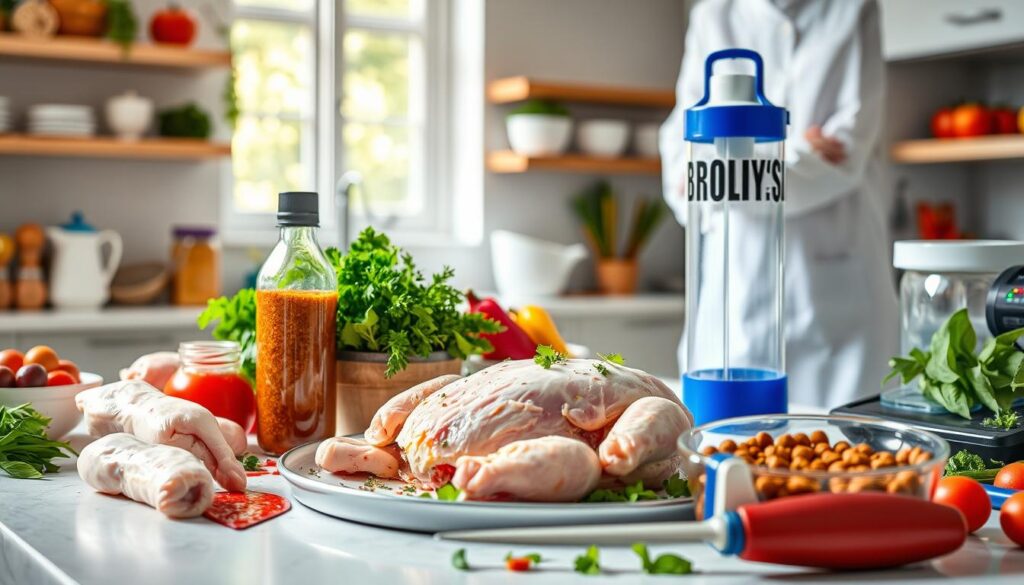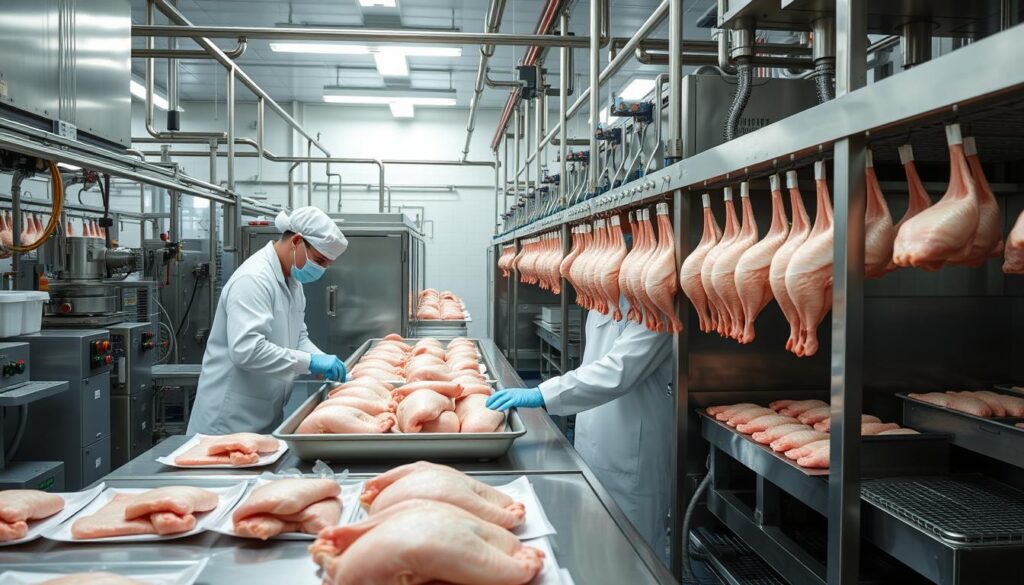
Poultry meat is very affordable and loved by many around the world. In 2019, people in the world and the US ate about 14.7 kg of it each. This was more than any other meat, like pork or beef.
As the world’s population grows, so will the demand for poultry meat. To keep up, farmers have improved how they raise and feed broilers. But, these fast-growing birds sometimes have lower meat quality. This can affect how good the meat tastes and feels.
This article will look at how processing can make broiler meat better. We’ll see how it can make the meat more tender, flavorful, and nutritious.
Key Takeaways
- Poultry meat is a popular and affordable protein source, with per capita consumption rates of around 14.7 kg globally and in the US in 2019.
- Fast-growing broilers often exhibit unfavorable meat quality attributes, such as reduced water holding capacity, increased incidence of myopathies, and impaired texture and flavor.
- Processing techniques can play a crucial role in enhancing broiler meat quality by improving tenderness, flavor, and nutritional value.
- Understanding the impact of processing methods on broiler meat quality is essential for meeting the growing global demand for poultry products.
- Optimizing processing techniques can lead to improved consumer acceptance and increased value of broiler meat.
Introduction to Broiler Meat Quality
Broiler meat quality is key for the poultry industry’s success. It affects how consumers see the meat, how it’s processed, and the industry’s profits. The importance of broiler meat quality is clear. It must meet changing consumer needs for healthy, tasty poultry.
Importance of Broiler Meat Quality
Broiler meat quality has many important aspects. Key attributes of broiler meat quality include how it looks, feels, tastes, and smells. These features are what consumers notice and judge before and after buying.
For those who make the meat, other qualities are just as important. These include how well it holds water, its texture, and how long it lasts. These qualities help make a product that’s not only good but also profitable.
Key Attributes of Broiler Meat Quality
The key attributes of broiler meat quality are vital for both buyers and makers. They include:
- Appearance: Color, marbling, and overall visual appeal
- Texture: Firmness, tenderness, and mouthfeel
- Juiciness: Moisture content and water-holding capacity
- Odor and Flavor: Desirable aromas and taste profiles
- Nutritional Value: High protein content and low caloric value
With more people caring about their health, they’re looking for nutritious foods. Poultry meat is a great choice because it’s full of nutrients and has fewer calories.
“The quality of broiler meat is a critical factor in the success of the poultry industry, as it directly impacts consumer perception, processing efficiency, and overall profitability.”
Factors Affecting Broiler Meat Quality
The quality of broiler meat is shaped by genetics, nutrition, and environment. Modern broiler chickens grow fast thanks to breeding. But, this fast growth can make meat quality a challenge.
Genetics and Breeding Impact on Broiler Meat Quality
Broiler chickens have grown a lot in 70 years. They eat less and grow faster. But, this fast growth can make their meat less tasty and tender.
They also get more fat and have muscle problems. These issues are common in today’s fast-growing broilers.
Nutrition and Feeding Impact on Broiler Meat Quality
What broilers eat is key to their meat quality. Bad bacteria, coccidiosis, and heat stress can harm their meat. But, good food like probiotics and plant extracts can help.
These foods boost their health and meat quality. They make broilers stronger and their meat better.
Environmental Conditions Affecting Broiler Meat Quality
Where broilers live also affects their meat. Heat stress is a big problem. It makes them eat less and get sick more.
Keeping the right temperature and air is important. It helps broilers stay healthy and their meat quality stays good.
By focusing on genetics, nutrition, and environment, the broiler industry can improve meat quality. The research in this field helps the industry make better meat for consumers.
Pre-Slaughter Handling and Management
Proper handling and management before slaughter are key for quality broiler meat. Each step, from transport to stunning and slaughter, affects the final product.
Transportation and Lairage
Transporting and lairaging birds carefully is vital for their welfare. Withholding feed 8 to 12 hours before slaughter helps prevent contamination. It’s also important to protect them from the weather and ensure good air flow during transport.
Keeping birds in a cool, weather-proofed area before slaughter is crucial. It reduces holding time and keeps conditions optimal.
Stunning and Slaughter Methods
The methods used for stunning and slaughter also impact meat quality. Poor techniques can cause quality issues like dark, firm, and dry meat. It’s essential to manage these steps carefully to avoid such problems.
| Key Statistic | Value |
|---|---|
| Feed withdrawal duration | 8 to 12 hours before processing |
| Average Dead on Arrival (DoA) rate | 0.29%, ranging from 0.02% to 1.89% per batch |
| Bruise incidence | 3.37% of birds, ranging from 0.43% to 8.29% per batch |
| Dehydrated carcasses | 2.68% of condemnations, observed in 22 out of 64 batches |
By managing pre-slaughter steps well, producers can improve meat quality. This maximizes the value of their products.
Primary Processing Techniques
Steps like scalding, defeathering, chilling, and aging are key in making broiler meat quality. It’s important to manage these steps well to keep the meat quality high.
Scalding and Defeathering Impact on Broiler Meat Quality
Scalding involves dipping broiler carcasses in hot water. It’s vital to control the temperature to avoid damaging the meat’s color and texture. If the scalding is too hot, it can make the meat look pale and soft.
After scalding, the defeathering process must be done carefully. Too much force or the wrong method can hurt the meat’s look and feel.
Chilling and Aging Effects on Broiler Meat Quality
Quick chilling of broiler carcasses is important to stop quality problems like PSE. Aging the meat allows it to become tender and more flavorful.
| Processing Technique | Impact on Broiler Meat Quality |
|---|---|
| Scalding | Improper temperatures can lead to protein denaturation, affecting color and texture |
| Defeathering | Excessive force or improper technique can cause skin damage and bruising |
| Chilling | Rapid chilling is crucial to prevent quality defects like PSE |
| Aging | Allows for the completion of rigor mortis and tenderization of the meat |
Managing these primary steps well is key to keeping broiler meat quality high. This ensures the meat is of the best quality for consumers.
The Role of Processing Techniques in Enhancing Broiler Meat Quality
Processing techniques are key in the broiler industry. They help improve the quality of the meat. Factors like transportation, stunning, and chilling are managed carefully. This reduces quality defects and enhances color, texture, and flavor.
Broiler chickens usually travel less than 60 miles to the plant. This short distance helps keep the meat quality high. The processing speed is also controlled to reduce stress. Over 300 safety checks are made to ensure the meat is safe and of good quality.
Techniques like marination and cooking can make broiler meat more appealing. Understanding and using these processing techniques is crucial. It helps the industry produce safe and consistent meat products.
“Rapid cooling during chilling must be done in less than 40 minutes to prevent microbial growth and maximize shelf life.”
The role of processing techniques in improving broiler meat quality is vital. By managing processing stages well, the industry can enhance meat quality. This positively impacts the attributes that consumers value most.

Meat Quality Defects and Management
In the broiler industry, meat quality is very important. Any defects can hurt the product’s appeal and market value. Two big issues are Pale, Soft, and Exudative (PSE) meat and Dark, Firm, and Dry (DFD) meat.
Pale, Soft, and Exudative (PSE) Meat
PSE meat looks pale, feels soft, and loses a lot of water. It’s often due to stress before slaughter, causing a quick drop in pH after death. To fix PSE, we need to reduce stress before slaughter, control how we process the meat, and use the right chilling and aging methods.
Dark, Firm, and Dry (DFD) Meat
DFD meat is dark, firm, and dry. It’s usually from long-term stress before slaughter, leading to a high pH. To avoid DFD, we must handle the birds carefully and reduce stress during transport and holding.
Fixing these meat quality problems is key for the broiler industry. By knowing why they happen and using the right fixes, we can make better meat. This makes our meat more appealing and valuable in the market.
| Meat Quality Defect | Characteristics | Causes | Management Strategies |
|---|---|---|---|
| Pale, Soft, and Exudative (PSE) Meat | Pale color, soft texture, high water loss | Rapid postmortem pH decline, pre-slaughter stress | Minimize ante-mortem stress, control processing parameters, implement proper chilling and aging techniques |
| Dark, Firm, and Dry (DFD) Meat | Dark color, firm texture, dry appearance | Chronic pre-slaughter stress, high ultimate pH | Proper handling and minimizing stress during transportation and lairage |
“Addressing meat quality defects is essential for the broiler industry to produce high-quality, consistent, and desirable meat products.”
Further Processing and Value Addition
Beyond just processing, broiler meat producers can use many techniques to make their products better. Marination and brining and cooking and packaging methods are key. These methods add value and quality to broiler meat.
Marination and Brining to Enhance Broiler Meat Quality
Marination and brining make broiler meat better. They improve how well the meat holds water, its tenderness, and taste. By soaking the meat in special solutions, producers add qualities that health-aware consumers like.
This step also helps with issues like Pale, Soft, and Exudative (PSE) meat. PSE meat can affect how the meat looks, tastes, and holds together.
Cooking and Packaging Methods Improving Broiler Meat Quality
How broiler meat is cooked and packaged greatly affects its quality and how long it lasts. Methods like grilling, roasting, or sous vide cooking make the meat juicier and tastier. New packaging ideas, like vacuum-sealing, keep the meat fresh longer.
By using these methods, producers can make high-quality, appealing products. These products meet the needs of health-conscious consumers.

“The increase in urbanization, industrialization, improved income levels, and changing food habits are seen as positive factors for the development of value-added processed food products in the poultry industry.”
Quality Assurance and Grading Systems
In the broiler meat industry, quality assurance and grading systems are key. They ensure the meat is always top-notch. These systems check the carcass’s looks, like shape and skin condition.
But, we also need to look at the meat’s function. This includes how well it holds water, its texture, and nutrition. These factors affect how people like and trust the meat. The USDA in the US and the Government of Canada have set Broiler Meat Grading Systems and Regulatory Standards for Broiler Meat Quality. The industry follows these to keep consumer trust and meet new market needs.
Broiler Meat Quality Assurance programs are vital. They protect public health and build trust in the broiler meat industry. These programs make sure the meat is safe and of high quality. They do this through strict quality checks, tracking, and following rules.
| Broiler Meat Quality Assurance Practices | Description |
|---|---|
| Carcass Inspection | Detailed inspection of broiler carcasses for defects, conformation, and overall quality characteristics. |
| Sensory Evaluation | Assessment of meat color, texture, aroma, and flavor to ensure consistent eating quality. |
| Microbial Testing | Regular testing for the presence of harmful bacteria to ensure food safety and prevent spoilage. |
| Temperature Control | Maintaining appropriate temperature levels throughout the processing and storage chain to preserve meat quality. |
| Traceability | Sophisticated tracking systems to ensure full traceability of broiler meat products from farm to fork. |
By using strong Broiler Meat Quality Assurance programs and following Broiler Meat Grading Systems and Regulatory Standards for Broiler Meat Quality, the industry can offer safe and reliable meat. This meets consumer expectations and builds trust.
Conclusion
The broiler industry has seen big improvements in making meat production more efficient. But, the fast growth and genetic changes in modern broilers have caused some problems. These include more fat, muscle issues, and quality problems like PSE and DFD meat.
Things like genetics, diet, environment, and how birds are handled before slaughter all play a big role in meat quality. By managing these well and using smart processing techniques, the industry can make meat better and more consistent.
This approach is key to meeting the world’s growing need for chicken and to please health-aware consumers. It’s all about finding a balance between making more meat and making it of higher quality.
The Conclusion on Processing Techniques for Enhanced Broiler Meat Quality shows how important it is to tackle the main factors affecting meat quality. This includes genetics, diet, and how birds are handled before slaughter. By taking a complete view, the broiler industry can offer top-notch, consistent, and valuable chicken products that meet today’s consumer needs.